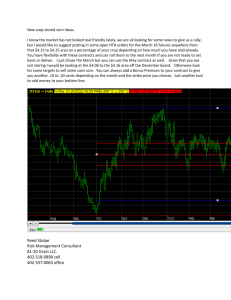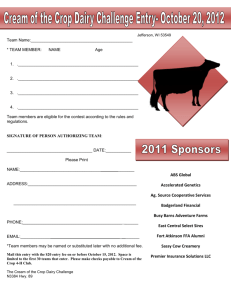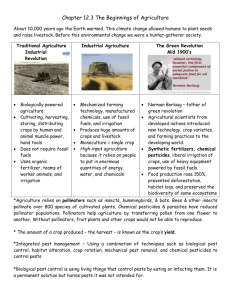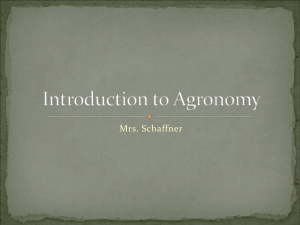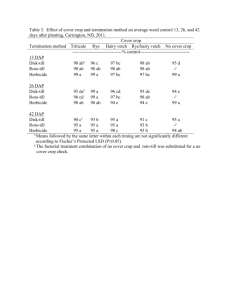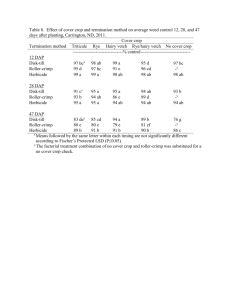Crops and Transpiration Rates
advertisement
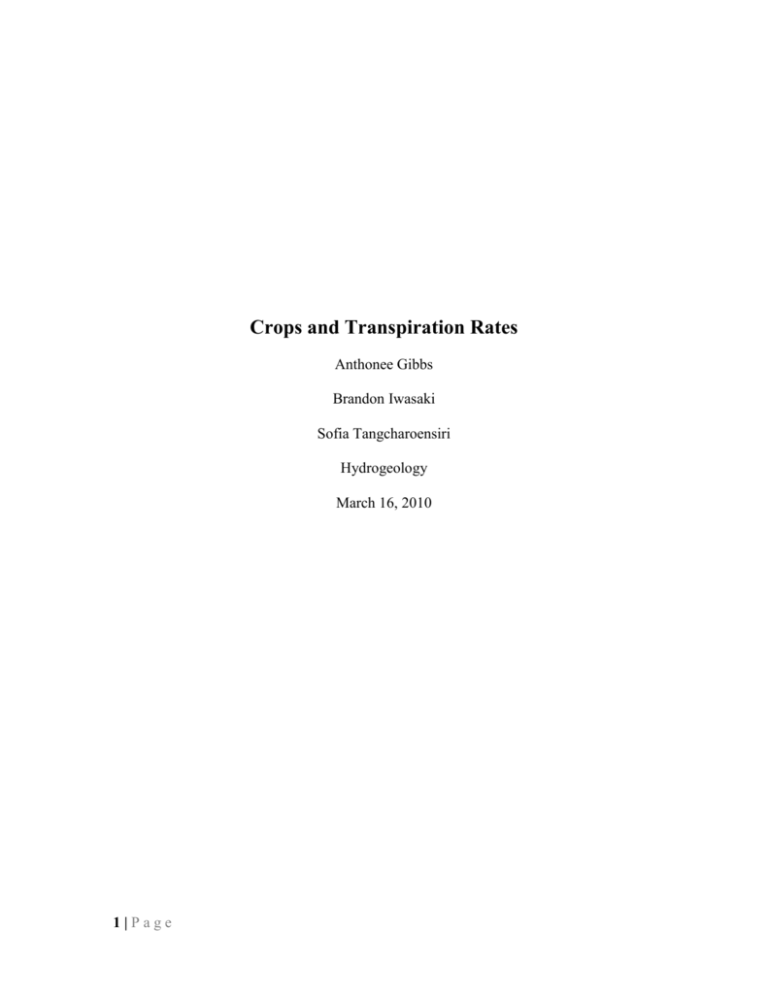
Crops and Transpiration Rates Anthonee Gibbs Brandon Iwasaki Sofia Tangcharoensiri Hydrogeology March 16, 2010 1|Page Table of Contents ABSTRACT ................................................................................................................................................ 3 INTRODUCTION........................................................................................................................................ 3 METHODS AND PROCEDURES .................................................................................................................. 6 RESULTS ................................................................................................................................................... 7 DISCUSSION: ............................................................................................................................................ 7 FUTURE RESEARCH: .................................................................................................................................. 7 CONCLUSION: .......................................................................................................................................... 8 CITATION OF SOURCES: .......................................................................................................................... 10 APPENDIX: ............................................................................................................................................. 11 2|Page Abstract Determining water needs for a field of varying crops can be a very daunting task in the initial stages. Multiple variables exist and several of them are directly linked. Our research calculated the water needs from a portion of the overall crop list with a fair amount of detail. We were able to isolate data from different stages of plant growth to improve accuracy of each individual plants water need. Still, several obstacles were encountered surrounding data retrieval during the investigation since most of the data is not well publicized. We were, however, able to determine local values for a few key variables that allowed us to calculate irrigation requirements with high certainty. Although error may be present in some of the researched values because the data is old, we feel confident in the data sources. During our investigation, we were able to find alternative methods for calculating true values that are exclusively location specific. If 21-Acres farm wishes to pursue such pathways, it would be easy for them to reference this paper and find relevant information. Introduction Finding irrigation requirements for specific farming locations can be a difficult procedure. There is a wide array of variables that must be considered when attempting to find a tangible end result. Working with 21-Acers, we hoped to help them find an irrigation plan that best fit their particular needs. 21-Acres provided an upcoming crop list that included crop varieties along with a planting itinerary. Research conducted through a multitude of sources provided our group with a method for determining specific crop irrigation needs based on the data Dave provided. When considering irrigation needs, usually a single plant’s use of water is calculated. The process by which water is lost in the plant’s environment is called evapotranspiration. In this process, water is transferred from soil and plant surfaces in the form of water vapor.-4 Research done in our project estimates the amount of Evapotranspiration that is occurring to achieve irrigation requirements. Typically, the concept of Evapotranspiration is discussed in two forms: potential evapotranspiration (ETp) and reference evapotranspiration (ETo).-4 3|Page Potential Evapotranspiration was developed by Penman during the 1940s and is considered as the platform for which reference evapotranspiration was built upon. -4 The reason reference evapotranspiration works better is because it standardizes key terms in the definition of the process. Reference Evapotranspiration is defined as “the rate of evapotranspiration from a hypothetical reference crop with an assumed crop height of 0.12m, a fixed surface resistance of 70 sec m-1 and an albedo of 0.23, closely resembling the evapotranspiration from an extensive surface of green grass of uniform height, actively growing, well-watered, and completely shading the ground.” -4 This definition is very specific, making it a standardized reference value that can be used to determine the evapotranspiration rates of other plants. Actual calculations for reference evapotranspiration are conducted usually with sophisticated computer models since they are very complex when considering all the true values. The Penman-Monteith equation considers all relevant information when considering ETo. Equation 1 Penman-Monteith Reference Evapotranspiration Equation-2 where ETo reference evapotranspiration [mm day-1], Rn net radiation at the crop surface [MJ m-2 day-1], G soil heat flux density [MJ m-2 day-1], T air temperature at 2 m height [°C], u2 wind speed at 2 m height [m s-1], es saturation vapour pressure [kPa], ea actual vapour pressure [kPa], es - ea saturation vapour pressure deficit [kPa], slope vapour pressure curve [kPa °C-1], psychrometric constant [kPa °C-1]. However, calculating the ETo using the Penman-Monteith Equation was far beyond the scope of what we felt was required in our portion of this project. Rather, we relied on research to provide us with reference evapotranspiration rates, using monthly values from 4|Page Monroe. We decided this location was closest available data to the Woodinville location of 21-Acres. Developing irrigation plans using a reference evapotranspiration was our plan for determining the specific evapotranspiration rates for each crop. This can be done by finding a crop coefficient. The crop coefficients, Kc, are a fixed variable that differs among different crop species. -2 After obtaining the crop coefficient, it is then possible to find the specific evapotranspiration for the corresponding crop based on the reference evapotranspiration (ETo). The coefficient adjusts several values to configure the ETo into the crops specific evapotranspiration value based on the following: Crop height. The crop height influences the aerodynamic resistance term, ra, of the FAO Penman-Monteith equation and the turbulent transfer of vapour from the crop into the atmosphere. Albedo (reflectance) of the crop-soil surface. The albedo is affected by the fraction of ground covered by vegetation and by the soil surface wetness. The albedo of the crop-soil surface influences the net radiation of the surface, Rn, which is the primary source of the energy exchange for the evaporation process. Canopy resistance. The resistance of vapour transfer is affected by leaf area (number of stomata), leaf age and condition, and the degree of stomatal control. The canopy resistance influences the surface resistance, rs. Evaporation from soil, especially exposed soil.-2 Unfortunately, we were not able to obtain Kc values for every crop listed on planning growing list. The upside, however, was finding accurate data of a select list of crops. From this list, we ultimately felt able to provide a fairly accurate representation of how evapotranspiration was affecting the specific plants at 21-Acres. We were able to find irrigation requirements for the fields for particular crops. The end form of these values was a conversion to gallons that is based on the amount of area each particular plant covers. It will then be possible for Dave to have a good estimate of his irrigation needs to keep growing fields between the wilting point and field capacity. 5|Page Methods and Procedures Calculation procedures were based on a simple equation of ETcrop = ETo * Kc, (Equation 2) where we were about to obtain both the Kc and ETo values to find evapotranspiration that was crop specific-1. The Kc values used were provided relied on different values specific to the growing stages of each particular crop. Plants transpire different amounts of water depending on the present stage in the growing cycle. Figure 1: Crop Growth Stages The growing period is divided into four stages of growth.-2 1. The initial stage: the period from sowing or transplanting until the crop covers ~10% of the surrounding ground. 2. The crop development stage: following the initial stage, the development stage lasts until the plant has its full potential ground cover 70%-80%. 3. The mid-season stage: after growing to its full potential, the crop begins flowering and grain-setting during this stage. 4. The late season stage: this period goes up until the last day of harvest. During this time ripening of the desired output will occur. After considering growing stage, each crop must be broken down depending on several factors. These include; planting date, harvest date, growing span, days spent in each stage and particular Kc values for those stages (Appendix 1). Since each of these values is plant specific, we were able to compute a Kc value for each plant during each growing month (Appendix 3). We then used corresponding monthly ETo data (Appendix 2) to reach a ETcrop value that was broken down by crop per month (Equation 2). To find the actual watering needs, local rainfall must be found. Typically, historical data on the site is relied upon to estimate future rainfall. We were able to find rainfall data from a Washington State Irrigation guide (Appendix 2). 6|Page The final equation produces a suggested watering value based on a vertical distance of water over an arbitrary area. We calculated that for every inch of water the plant requires, it must be watered .64 gallons per square foot that it covers. For example, if a plant requires 2 inches of water during some time and it covers 1 square foot of soil, the plant must be watered 1.28 gallons over the time period. Results Our results consist of a fairly detailed chart displaying inches of watering requirement needed for each plant. In some months, there were fewer numbers of crops which didn’t have high water needs. This made the net watering total for a May and September negative, meaning there was a surplus. There are irrigation needs in both inches for each plant like rainfall measurements. The second set of data is manipulated to consider a volumetric measurement (gallons), by relying on a fixed unit of area (one square foot). This data can be seen displayed in Table 1. Table 1: Calculated Irrigation Requirements Discussion: With our transpiration data we have a general idea of how much water will be needed at 21-Acres. Since we were only able to get data for 16 of approximately 50 plants we won’t be able to directly calculate an exact amount of water needed at 217|Page Acres. With the results we have along with assumptions that the other plants are near the “average” of the 16 plants we calculated, Dave may be able to come up with a very rough figure for the amount of additional water needed. Our calculations won’t be exact because we are using a reference crop which there is room for error. Furthermore, the actual rain in a given month or day is going to be different than the average rain per month we found. To go into further detail, not every plant is going to take the same amount of water as the next. If there are some plants that are in a lower spot on the field they may need no additional water, or if one half of the field receives more shade from bordering trees during the day. A similar report has been done for select cities in Washington State which entails the crop irrigation requirements for certain plants. The closest city we could find was Monroe. Monroe is located about 15 miles north east of Woodinville. Monroe has similar weather to 21-Acres since they are near each other. Monroe had values for half of the crops that we were able to find a crop coefficient for. Of those values our calculations were off for every one. The closest we came was to be within .2 of an inch, and the greatest variation of almost 5.6 inches was for beans-5. This variation could be due to multiple factors. It could be the weather difference since the study was being done in a different area. It may also have to do with the porosity of the soils or the type of plant. There are hybrids of beans which could have a much higher or lower water requirement. Even with this variation we feel our data will still be crucial information for Dave to use so he can determine how much total water will be needed throughout the year. We wish we could have been able to find more crop coefficients so we would be able to determine his water needs, but we were not able to find the information. It is likely that there is no data for certain plants which Dave is going to be growing this year. This may be a factor because some of the plants are hybrids, new or just unpopular plant types. Future Research: Since we were not able to find values for all the plants that were going to be harvested this year we have a few ideas on how Dave can come up with his own values for the plants he would like to grow. In our research we came up with two different ways 8|Page to determine the transpiration rates for plants. These methods would have taken more than the allotted time during the quarter which is why we found estimates. The two ways are the Tent method and the Potted-plant method-1. The first is for larger plants that won’t fit in small to medium pots and the second is for the plants that will fit into pots. In the Tent method you cover the plant with a plastic bubble and have one inlet and one outlet. You monitor the moisture content entering and leaving the tent. If there is more moisture leaving than entering the difference is your evaporation rate-1. In the Pottedplant method you water the plant until it is at field capacity and cover the soil with plastic to deter soil evaporation. You then weigh the plant “wet” and again “dry” and your transpiration rate is the difference over that period of time-1. With these two methods Dave should be able to determine the transpiration rates of the plants throughout the year and at different growth stages of the plant. With this additional information he will have an even better grasp on the watering needs of the crops. Conclusion: Throughout the project we encountered numerous problems with our data. The biggest problem we had was not being able to get a hold of Dave until a week and a half before our due date. Once we figured out which plants to focus on we still had difficulty researching them to find out their water usage. Overall we were able to help Dave out by getting information he deemed sufficient for his practical use even though we weren’t able to come up with an exact number for how many gallons per month or day he was going to have to use due to the lack of data. If we were to do anything differently we would likely try and come up with our own crop coefficient values for each individual crop. Since we were on a time constraint of the quarter system we didn’t get a chance to try out the tent or potted plant methods which would give us a much better estimation of each plants water usage-1. With the water usage we determined for the plants Dave will then have a decent understanding of the requirements per plant and can water the crops according to how many seedlings he decides to plant at 21-Acres. 9|Page Citation of Sources: 1. Brooks, K. DeBano, K. Ffolliott, P. Gregersen, H. (2003). Hydrology and the Management of Watersheds. Iowa. Blackwell Publishing Professional. 2. Crop Water Needs. Retrieved March 12, 2010 from, http://www.fao.org/docrep/s2022e/s2022e07.htm 3. Climactic Stations for Consumptive Use. Retrieved on March 12, 2010 from http://bb.uwb.edu/webapps/portal/frameset.jsp?tab_id=_2_1&url=%2fwebapps% 2fblackboard%2fexecute%2flauncher%3ftype%3dCourse%26id%3d_1095_1%26 url%3d 4. Irmak S. Haman D. Evapotranspiration: Potential or Reference. Retrieved on March 12, 2010 from http://bb.uwb.edu/webapps/portal/frameset.jsp?tab_id=_2_1&url=%2fwebapps% 2fblackboard%2fexecute%2flauncher%3ftype%3dCourse%26id%3d_1095_1%26 url%3d 5. Washington State- West of Cascades CIR- Crop Irrigation Requirement and CUCrop Consumptive Use. Retrieved March 12, 2010 from, http://bb.uwb.edu/courses/1/BES318W10/content/_59191_1/Irr_Guide_Appendix_B.pdf?bsession=1408716&bsession _str=session_id%3D1408716,user_id_pk1%3D2909,user_id_sos_id_pk2%3D1,o ne_time_token%3D2E8231899C12BE5FA19EF3A8E5AD2F35&bsession_md5= 2FF9776B6AF6FDBFE4CC8A29C5FAAAD9 10 | P a g e Appendix: Crop Name Beans Cabbage Carrots Cucumber Eggplant Lettuce Melon Onion Peas Peppers Potato Radish Edamame Spinich Squash Tomato Initial Stage(days) Ini. Kc Crop dev. Stage(d) Dev Kc 20 0.35 30 0.7 20 0.45 25 0.75 20 0.45 30 0.75 10 0.45 20 0.7 10 0.45 20 0.75 10 0.45 20 0.6 15 0.45 25 0.75 15 0.45 30 0.75 15 0.45 25 0.8 20 0.35 30 0.7 15 0.45 25 0.75 5 0.45 5 0.6 20 0.35 30 0.75 20 0.45 30 0.6 20 0.45 30 0.7 30 0.45 40 0.75 Appendix 1: Crop Coefficient Values Based on Stage Crop Name Beans Cabbage Carrots Cucumber Eggplant Lettuce Melon Onion Peas Peppers Potato Radish Edamame Spinich Squash Tomato Mid-season Stage(d) 31 60 30 20 30 10 30 25 30 35 25 10 60 40 30 40 Mid Late Season Season Kc Stage(d) 1.1 1.05 1.05 0.9 1.15 1 1 1 1.15 1.05 1.15 0.9 1.1 1 0.9 1.15 Appendix 1: (continued): Crop Coefficient Values Based on Stage 11 | P a g e 31 16 10 12 10 4 18 8 8 15 9 7 25 10 15 25 Late Season Kc 0.9 0.9 0.9 0.75 0.8 0.9 0.75 0.75 1.05 0.9 0.85 0.9 0.6 0.9 0.75 0.8 Month Effective Precip (in) Eto (in) May 2.05 4.15 Jun 1.8 4.78 Jul 1.03 5.67 Aug 1.28 4.54 Sep 1.93 3.16 Appendix 2: Local Rainfall and Reference Evapotranspiration Values from Monroe, WA Appendix 3: Calculating Kc Values for Each Crop per Month 12 | P a g e
